RBSE Solutions for Class 7 Science Chapter 2 Nutrition in Animals are part of RBSE Solutions for Class 7 Science. Here we have given Rajasthan Board RBSE Class 7 Science Chapter 2 Nutrition in Animals.
| Board | RBSE |
| Textbook | SIERT, Rajasthan |
| Class | Class 7 |
| Subject | Science |
| Chapter | Chapter 2 |
| Chapter Name | Nutrition in Animals |
| Number of Questions Solved | 47 |
| Category | RBSE Solutions |
Rajasthan Board RBSE Class 7 Science Chapter 2 Nutrition in Animals
Textbook Exercise
Choose the most appropriate option
Question 1.
Number of incisors in Buccal cavity of human being:
(a) 2
(b) 4
(c) 6
(d) 8
Answer:
(d) 8
Question 2.
Organ in which absorption of digested food takes place:
(a) stomach
(b) small intestine
(c) large intestine
(d) mouth
Answer:
(b) small intestine
Question 3.
A part of our body which has digestive juice:
(a) large intestine
(b) Small intestine
(c) stomach
(d) oesophagus
Answer:
(c) stomach
Question 4.
Fill in the with approprate words blanks:
1. Amoeba captures food with the help of …………. .
2. In ruminants, ………………. is located between the small intestine and large intestine.
3. By ………………… on the tongue reveals taste.
Answers:
1. Pseudopodia
2. caecum
3. taste buds.
Short Answer Questions:
Question 1.
What is the process of ingestion?
Answer:
The intake of food from mouth is called ingestion. Amoeba has no mouth. Therefore, this process in amoeba is known as endocytosis.
Question 2.
If tongue doesn’t has a taste bud than which process is affected?
Answer:
The taste buds on the tongue tell us the taste of food. When the food tastes good, appetite increases. If taste buds are absent we cannot taste food and it affects our appetite.
Question 3.
If ruminants doesn’t have caecum what happened?
Answer:
The intestine of ruminants have some bacteria in the caecum which helps in digestion of cellulose present in the food. If caecum is not present in these animals, digestion of cellulose is not possible.
Question 4.
Write the name and functions of different types of teeth of humans.
Answer:
Types of teeth and their functions:
- Incisors – Your incisors are eight teeth in the front center of your mouth (four on both bottom and top). Incisors are the teeth that you use to bite into your food.
- Canines – You have four of them and they are your sharpest teeth, used for tearing apart food.
- Premolars – Premolars are used for tearing and crushing food. Unlike your incisors and canines, premolars have a flat biting surface. You have eight premolars in total.
- Molars – Your molars are your largest teeth. Their function is similar to that of the premolars, to grind, tear, and crush food.
Long Answer Type Questions
Question 1.
How do digestion of food takes place in stomach?
Answer:
When food reaches the stomach, there is muscular contraction in the walls of stomach due to which food is crushed. Glands present in the stomach secretes hydrochloric acid and gastric juice. Hydrochloric acid makes the medium of stomach acidic and destroys the micro-organisms which comes with the food. It also encourages secretion of gastric juice. Gastric juice contains some digestive enzymes that decompose protein into simpler substances. These enzymes act in acidic medium in stomach. Food becomes pulpy in stomach which is then pushed into small intestine.
Question 2.
Describe a method of feeding and digestion in Amoeba by a labeled diagram.
Answer:
Digestion in Amoeba: Amoeba is an unicellular organism found in aquatic reservoirs. There is a cell membrane surrounding cells of amoeba. There is a large central nucleus, cytoplasm and various bubbles like contractile vacuoles in amoeba. Amoeba continuously changes its shape and position. It develops various finger like projections called pseudopodia. Pseudopodia help in movement and holding food. Amoeba takes some micro-organisms in the form of food. When amoeba smells any food , it develops pseudopodia around the food and engulf it.
The food particle enclose in the food vacuole. This process is known as endocytosis. The food vacuole contains digestive enzymes. With the help of digestive enzymes, the engulfed food is digested in the food vacuoles. Two enzymes amylase and proteinase have been reported. Thus amoeba can digest carbohydrates and proteins. Now the digested food becomes liquid in the food vacuole. Now this digested food diffuse to the cytoplasm from the food vacuole.
It is done by simple diffusion method. The undigested food remains in the food vacuole. This digested food becomes the part of protoplasm. Some food is used to generate energy by the process of respiration and remaining food is stored as reserved food in the protoplasm. The undigested food is sent near the cytoplasmic membrane and is thrown in the surrounding. This process is known as egestion.
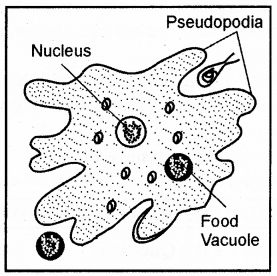
Digestion in Amoeba
Question 3.
Draw a labeled diagram of digestive system of humans.
Answer:
Digestive system in humans:
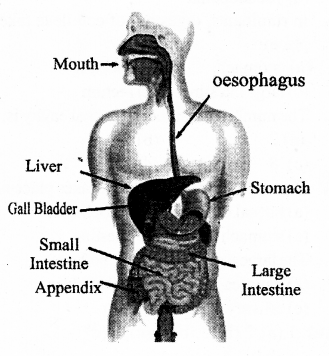
Intext Questions
Question 1.
Have you ever wondered what happens to the food inside the body? (Page 15)
Answer:
The food passes through a continuous canal which begins at the buccal cavity and ends at the anus.
Question 2.
Are all teeth alike in appearance ? What is the difference in the texture of the teeth ? What is the difference in their functions. (Page 16)
Answer:
No, all teeth are not same. There is difference in structure and functions of teeth. Some are pointed while some are broad. There are different teeth for cutting, tearing, chewing etc.
Question 3.
Do you know the functions of tongue? (page 18)
Answer:
We use our tongue for talking. Besides, it mixes saliva with the food during chewing and helps in swallowing food. We also taste food with our tongue. It has taste buds that detect different tastes of food.
Question 4.
Can you guess what is the role of villi could be in the intestine? (page 19)
Answer:
The villi increase the surface area for obsorption of the digested food. Each villus has a network of thin and small blood vessels close to its surface. The surface of the villi absorbs the digested food materials.
Activity
Question 1.
Draw a diagram of digestive system on chart, hard sheet, thermocol and colour its different parts by different colours. Thereafter cut the different parts. We can do different activities by pieces.
Answer:
For example:
- A student of the class will speak the name of the organs and another student pick it and tell the name.
- Make digestive system by joining pieces.
- Identification of various organs by bandaging on eyes.
- Sit in Vajrasana for 5 minutes after the meal.
Question 2.
Prepare a chart of digestive system and fix in a class room.
Answer:
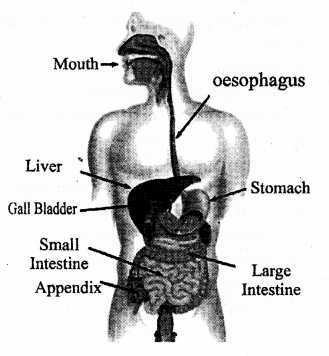
Other Important Questions
Multiple Choice Questions
Choose the correct option from the following:
Question 1.
In amoeba digestion of food takes place in
(a) contractile vacuole
(b) cell membrane
(c) nucleus
(d) pseudopodia
Answer:
(a) contractile vacuole
Question 2.
In ruminants, digestion of cellulose takes place in:
(a) stomach
(b) caecum
(c) large intestine
(d) rectum
Answer:
(b) caecum
Question 3.
The number of canines in buccal cavity is:
(a) 2
(b) 4
(c) 8
(d) 12
Answer:
(b) 4
Question 4.
The secretion of gastric juice takes place in:
(a) buccal cavity
(b) oesophagus
(c) stomach
(d) intestine
Answer:
(c) stomach
Question 5.
The largest gland in human body is:
(a) pancreas
(b) gall bladder
(c) salivary gland
(d) liver
Answer:
(d) liver
Fill in the blanks:
1. The process of conversion of complex food molecules into simpler one is called ……………….. .
2. Amoeba takes …………………… as food.
3. ……………………. is abundant in grass which is a type of carbohydrate.
4. ………………… converts complex molecules into simpler molecules.
5. Inner surface of stomach secretes mucus, ……………….. and digestive juice.
Answer:
1. Digestion
2. Micro – organisms
3. Cellulose
4. Digestive juice
5. Hydrochloric acid
Very Short Answer Questions:
Question 1.
How humans and other living organisms obtain food?
Answer:
Humans and other living organisms obtain food indirectly from plants.
Question 2.
What is endocytosis?
Answer:
The engulftnent of micro-organisms by amoeba is called endocytosis.
Question 3.
What is rumen?
Answer:
First stomach of ruminants in which they collect food after eating is called rumen.
Question 4.
What is cud?
Answer:
Partly digested food returns from the first stomach of ruminants to the mouth for further chewing is called cud.
Question 5.
What is alimentary canal?
Answer:
In humans, a continuous tube starting from buccal cavity to anus is called alimentary canal.
Question 6.
How many types of teeth are found in humans?
Answer:
There are four types of teeth:
- Incisor
- Canine
- Molar
- Premolar
Question 7.
What is ingestion?
Answer:
The process of taking food inside the body is called ingestion.
Question 8.
How is food pushed down in oesophagus?
Answer:
The walls of oesophagus contracts which helps in movement of food down.
Question 9.
Where is bile juice formed and collected ?
Answer:
Bile juice is formed in liver and collected in gallbladder.
Question 10.
Write the length of small intestine and large intestine in humans?
Answer:
Small intestine: 6 – 8 m and large intestine – 1.5 m approx.
Short Answer Type Questions:
Question 1 .
What is Rumination? Explain.
Answer:
Cow, buffalo and other grass eating animals continuously ruminate even when they are not eating grass. Actually they swallow grass and collect it in one part of stomach. This part is called mmen or first stomach. Here, partial digestion of food takes place which is called cud. But after sometime food is again sent back to mouth in small lumps and chew it. This process is called Rumination and such organisms are called ruminants.
Question 2.
Write the name of different organs of human digestive system.
Answer:
Human digestive system is made of alimentary canal and related digestive glands.
Parts of alimentary canal:
- Buccal cavity
- Oesophagus
- Stomach
- Small intestine
- Large intestine
- Rectum and anus.
Glands:
- Salivary glands
- Gastric glands
- Liver
- Pancreas.
Question 3.
Where are salivary glands situated? Write the importance of saliva?
Answer:
Salivary glands are situated in buccal cavity. Saliva is secreted by them. When we chew food, saliva is secreted from salivary glands and mixes with food. On mixing saliva, food becomes soft and slippery. Saliva also contains digestive enzyme. This enzyme partially digests the food. Soft and gummy food is easy to swallow.
Question 4.
What is tongue? Where is it situated? Write its functions.
Answer:
Tongue is a muscular organ which is situated in buccal cavity. Tongue is attached to the base of buccal cavity from back side. Its front side is free and can move in any direction. Tongue helps in speech, food taste, cleaning of teeth, swallowing and chewing food and mixing saliva to food.
Question 5.
Draw a diagram of oesophagus and stomach of human.
Answer:
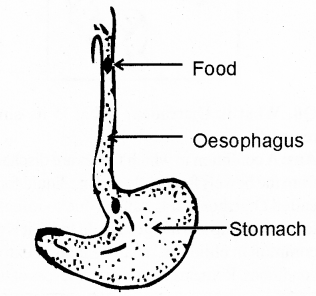
Question 6.
Write the structure and functions of Liver and Pancreas.
Answer:
Liver: Liver is dark brown coloured largest gland in the human body. Located in the right upper quadrant of the abdominal cavity, it rests just below the diaphragm, to the right of the stomach and overlies the gallbladder. It secretes bile juice which is stored and concentrated in the gallbladder. The main function of bile juice is digestion of fat.
Pancreas: The pancreas is a light coloured endocrine and digestive organ that, in humans, lies in the upper left part of the abdomen. It is found behind the stomach. The pancreas is about 15 cm (6 in) long. It secretes pancreatic juice. Pancreatic juice digests carbohydrates and protein into simpler forms.
Question 7.
Explain the structure of large intestine with diagram
Answer:
Large intestine is comparatively broad and smaller than small intestine. It is 1.5 m long. Its main function is absorption of water and some important salts.
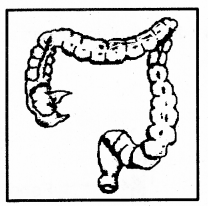
Question 8.
What is Diarrhoea? What is its simple remedy?
Answer:
A condition in which faces are discharged from the bowels frequently and in a liquid form is called Diarrhoea. It is caused due to infection, food poisoning and indigestion. In India, it is most common in children. It can be fatal in extreme conditions. Its main effect is extreme loss of water and salts in the body. It should not be neglected. Before going to doctor, a person should take solution of pinch of salt and sugar in boiled water. This solution is also known as O.R.S or life saving solution which can be obtained in government hospitals also.
Long Answer Type Questions
Question 1.
Draw a labelled diagram of digestive system of cow.
Answer:
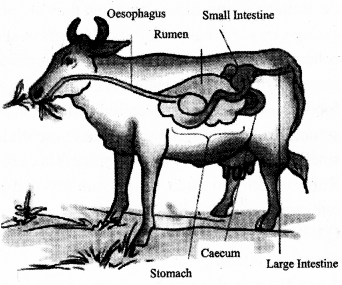
Question 2.
Tabulate the number, types and functions of teeth present in buccal cavity.
Answer:
| S.No. | Type of teeth | Upper jaw | Lower jaw | Total and property | Functions |
| 1 | Incisors | 4 | 4 | 8, sharp | bite food |
| 2 | Canine | 2 | 2 | 4, pointed | tearing food |
| 3 | Pre molars | 4 | 4 | 8, rough | chew food |
| 4 | Molars | 6 | 6 | 12, rough | chew food |
Question 3.
Why is it necessary to clean and take care of our teeth regularly? How teeth should be cleaned? What is tooth decay? How can it be prevented?
Answer:
Generally, bacteria are found in our mouth but these are not harmful for us. But if we do not clean teeth regularly after the meals, a large number of bacteria will grow in mouth. These bacteria decompose sugar present in food caught between the teeth and changes it to acid. This acid cause harm to teeth gradually, it is known as tooth decay. If it is not cured within time, it causes unbearable pain in teeth and finally teeth falls. Chocolate, cold drinks, sweet food etc, are responsible for it. Therefore, every person should brush their teeth twice a day and gargle after every meal. We should not put dirty finger and unwashed substance in our mouth.
Question 4.
Explain structure, digestion and absorption in small intestine.
Answer:
Small intestine is 6 to 8 m long and highly coiled. It accepts secretions from liver and pancreas. It also secretes some juice from walls of small intestine. In small intestine, digestion of protein, carbohydrates and fats takes place with the help of pancreatic juice and bile juice. Digested food is absorbed in small intestine. There are finger like projections on the inner walls of small intestine, These are called villi. Villi increase the surface area for absorption of digested food. Each villi has a network of blood vessels.
Absorption of digested food takes place on the surface of villi which then goes to blood vessels. Transportation of absorbed food takes place in different parts of body by these blood vessels. Here, it is used for the formation of complex substances. This process is known as Assimilation. Glucose present in cells decomposes into carbon dioxide and water in the presence of oxygen and energy is released. The part of food which is not digested or absorbed is moved to large intestine.
Question 5.
Write some of the good food habits which keep us healthy.
Answer:
Some of the things which should be kept in mind which keep us healthy are:
- Hands and mouth should be washed before and after the meal.
- Food should be taken in a clean space.
- Always eat clean and covered food.
- Eat food at definite time.
- Food should be taken tension free and patiently.
- Take balanced diet.
- Chew food properly.
- Take fiber rich food and green leafy vegetables as salad.
- Do not eat too much.
- Eat all types of food.
- Do not talk while eating.
- Drink water 1 hour after eating.
- Do not leave food unused because it is considered as “Anna Devta” in Granthas.
Question 6.
Why is Vajrasana important? Write its method.
Answer:
Vajrasana: Now a days, some of the stomach related problems such as acidity, constipation, indigestion etc., are increasing at higher rate. Vajrasana is done to prevent these problems.
Method:
- Put a mat on a smooth surface 5 minutes after the meal.
- Bend your knees and sit on your buttocks.
- The sides of your soles should be close together.
- Interlock your big toes.
- Maintain your posture so that your spine and neck are absolutely straight.
- Balance your body in this position while taking deep and even breaths.
- Do not lean back or allow your spine to arch backwards.
- Keep your eyes closed and remain conscious of your breathing.
- Inhale and exhale slowly and allow your mind and body to relax completely.
- Sit in this pose for a minimum of 2 minutes. Once you are used to it, you can increase this to 5-10 minutes.
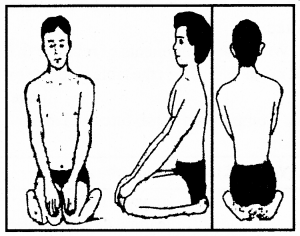
We hope the RBSE Solutions for Class 8 Science Chapter 2 Nutrition in Animals will help you. If you have any query regarding Rajasthan Board RBSE Class 8 Science Chapter 2 Nutrition in Animals, drop a comment below and we will get back to you at the earliest.